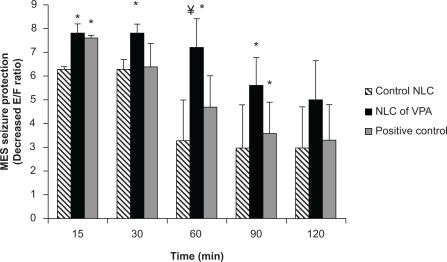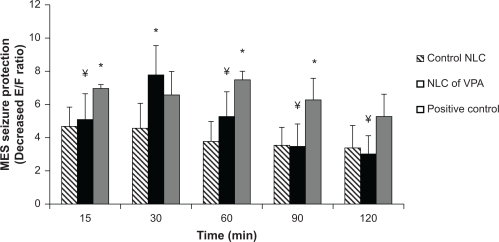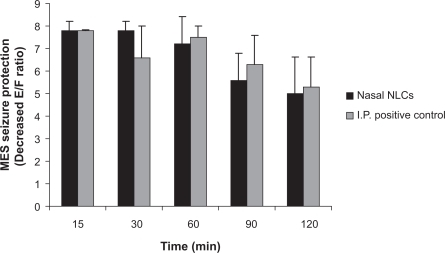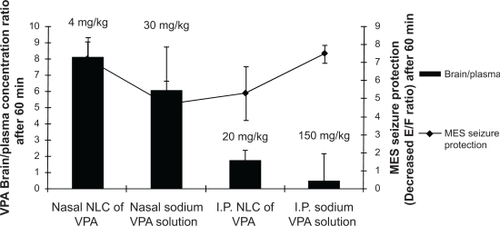Figures & data
Table 1 Preparations, dosage, routes, and times of administration of different preparations of VPA used in the different experimental groups
Table 2 Composition and physical properties of the optimized NLCs of VPA
Table 3 Concentration of VPA in plasma and brain after administration of different formulations (n = 6)
Figure 1 Comparison between the effect of sodium valproate solution positive control (30 mg/kg), NLCs of VPA (4 mg/kg), and control NLCs (without VPA) in nasal route of administration on MES seizure protection which was assessed as the decrease of extension:flexion (E:F) ratio (n = 6).
Notes: *Statistically significant difference (P < 0.05) with respect to the control (empty) NLC group according to one-way ANOVA and Tukey test; ¥Statistically significant difference (P < 0.05) with respect to the positive control group according to 1-way ANOVA and Tukey test.
Abbreviations: E:F ratio, extension:flexion ratio; VPA, valproic acid; NLC, nanostructured lipid carrier; MES, maximal electroshock.

Figure 2 Comparison between the effect of sodium valproate solution positive control (150 mg/kg), NLCs of VPA (20 mg/kg), and control NLCs (without VPA) in IP route of administration on MES seizure protection which was assessed as the decrease of extension:flexion (E:F) ratio (n = 6).
Notes: *Statistically significant difference (P < 0.05) with respect to the control (empty) NLC group according to one-way ANOVA and Tukey test; ¥Statistically significant difference (P < 0.05) with respect to the positive control group according to 1-way ANOVA and Tukey test.
Abbreviations: E:F ratio, extension:flexion ratio; VPA, valproic acid; NLCs, nanostructured lipid carriers; MES, maximal electroshock; IP, intraperitoneal.

Figure 3 Comparison between MES seizure protection effect of NLCs of VPA (4 mg/kg) in nasal route and sodium valproate solution (150 mg/kg) as positive control in IP route after different times of drug administration (P > 0.05) (n = 6). There is no statistical difference in any times according to independent t test.
Abbreviations: E:F ratio, extension:flexion ratio; VPA, valproic acid; NLCs, nanostructured lipid carriers; MES, maximal electroshock; IP, intraperitoneal.

Figure 4 Correlation between MES seizure protection effect and brain:plasma concentration ratio of preparations in nasal and IP route of administration.
Abbreviations: E:F ratio, extension:flexion ratio; VPA, valproic acid; NLC, nanostructured lipid carrier; MES, maximal electroshock; IP, intraperitoneal.
